Content for TS 23.379 Word version: 19.2.0
1…
7…
7.4…
10…
10.5…
10.6…
10.6.2.2.13…
10.6.2.2.24…
10.6.2.3…
10.6.2.3.1.2…
10.6.2.3.2…
10.6.2.4…
10.6.2.4.3…
10.6.2.5…
10.6.2.5.2.3…
10.6.2.6…
10.6.2.6.2…
10.6.2.7…
10.6.2.10…
10.6.3…
10.7…
10.7.2.2…
10.7.2.3…
10.7.3…
10.7.4…
10.7.5…
10.7.5.2.3a…
10.7.6…
10.7.6.2.3…
10.9…
10.9.1.3…
10.9.1.3.2…
10.9.1.3.3…
10.9.1.4…
10.9.1.5…
10.9.2…
10.9.2.6…
10.10…
10.12…
10.14…
10.15…
10.19…
10.19.2.11…
10.19.3…
10.19.3.1.4…
10.19.3.2…
10.19.3.2.4…
10.19.3.2.6…
A…
A.4…
B…
10.9.1.3.3 Queue position during an MCPTT session
10.9.1.3.4 Floor request cancellation from the floor request queue
10.9.1.3.4.1 Floor request cancellation from the queue - MCPTT user initiated
10.9.1.3.4.2 Floor request cancellation from the queue - floor control server initiated
10.9.1.3.5 Floor idle during an MCPTT session
10.9.1.3.6 Floor revoke by the authorized user
...
...
10.9.1.3.3 Queue position during an MCPTT session p. 177
Figure 10.9.1.3.3-1 shows the high level procedure that the floor control is conducted for the MCPTT session already established between MCPTT clients (with floor granted to floor participant B) and server (with an override based on priority at floor control server). Only two UEs involved in the session are shown for the simplicity.
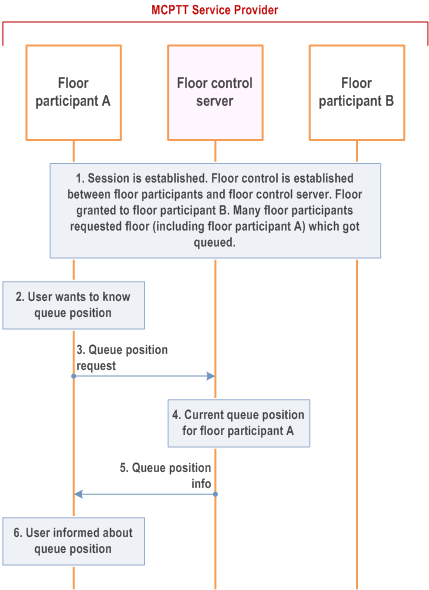
Step 1.
It is assumed that floor participant B has been given a floor granted and is transmitting voice media. There are several other floor participants (including floor participating A) requesting floor which get queued at the floor control server.
Step 2.
Floor participant A would like to know its current position in the floor request queue.
Step 3.
Floor participant A sends a queue position request message to the floor control server.
Step 4.
Floor control server determines the current queue position of floor participant A from the floor request queue.
Step 5.
Floor control server responds with the current position in queue position info message.
Step 6.
User at floor participant A is informed about the current queue position.
10.9.1.3.4 Floor request cancellation from the floor request queue p. 178
10.9.1.3.4.1 Floor request cancellation from the queue - MCPTT user initiated p. 178
Figure 10.9.1.3.4.1-1 illustrates the procedure for floor request cancellation from the floor queue initiated by the MCPTT user. The MCPTT user may be an authorized user who has rights to cancel the floor requests of other MCPTT users, whose floor requests are in floor control queue.
Pre-conditions:
- It is assumed that floor participant B has been granted the floor and is transmitting voice media. There are several other floor participants (including floor participant A and floor participant C) requesting the floor which have been queued at the floor control server.
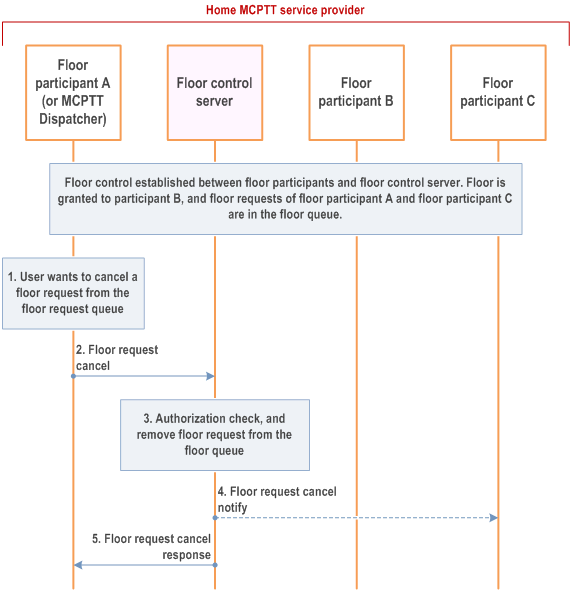
Step 1.
The floor participant A wants to remove the floor request from the floor request queue. If floor participant A is an authorized MCPTT user with the rights to cancel another MCPTT user's floor request, the authorized MCPTT user may request floor request cancellation for one or more floor participants, whose floor request needs to be removed from the floor queue.
Step 2.
The floor participant A sends a floor request cancel (initiating MCPTT ID) message to the floor control server. If the floor participant A wants to remove the floor request(s) of other participant(s), the target participant(s)' MCPTT ID should be included in this message.
Step 3.
The floor control server shall check whether the requesting floor participant has authorization to cancel the floor request(s). If authorized, the floor request(s) will be removed from the floor request queue. When current transmission is completed, floor control server will process the floor request from the updated floor request queue.
Step 4.
If the floor request cancel in step 2 is sent by an authorized user (e.g., dispatcher) to cancel the floor request(s) of other participant(s) from the floor request queue, the floor request cancel notify message is sent to the floor participant whose floor request was cancelled from the floor queue. The floor request cancel notify message is also sent to the authorized user (not shown in figure) if the floor request cancel in step 2 is sent by the floor participant A is an initiating MCPTT user.
Step 5.
The floor control server provides a floor request cancel response to the floor participant A when the floor cancellation is completed. Optionally, the new queue position information may be notified to the floor participants whose floor requests are in the floor request queue (not shown in the figure).
10.9.1.3.4.2 Floor request cancellation from the queue - floor control server initiated p. 179
Figure 10.9.1.3.4.2-1 illustrates the procedure for floor request cancellation from the queue initiated by the floor control server. Only three UEs involved in the session are shown for the simplicity.
Pre-conditions:
- MCPTT session is established between MCPTT clients (client A, client B, client C and client D) and MCPTT server.
- It is assumed that floor participant B (not shown in figure) has been granted the floor and is transmitting voice media. There are several other floor participants (including floor participant A and participant C) requesting the floor which have been queued at the floor control server.
- The user at MCPTT client D is an authorized user (e.g., dispatcher) allowed to remove a floor request of other MCPTT users from the floor queue and can receive notifications about another user when their floor request is queued, when their queued floor request is rejected and when their queued floor request is removed from the queue.
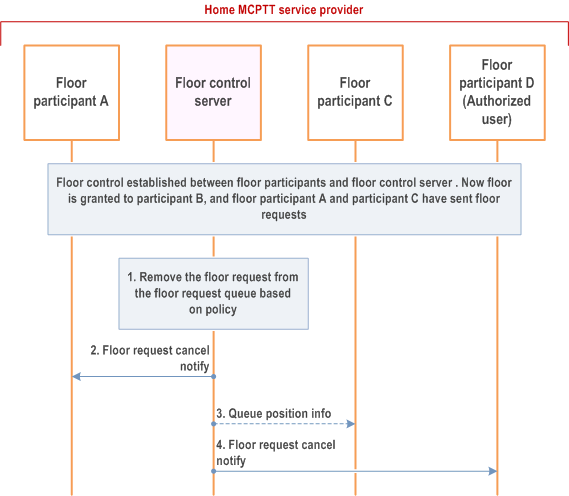
Step 1.
The floor control server removes the floor request from the floor request queue based on policy. e.g., expiration of a timer. In the case when floor control server receives repeated floor requests from a floor participant while the floor is occupied, the new floor request is accepted and added into the floor queue and the existing/former floor request is removed from the floor queue or the new floor request is rejected and the existing/former floor request of this floor participant is retained in the floor request queue.
Step 2.
The floor control server sends a floor request cancel notify to the floor participant(s) whose floor request is removed from the floor request queue.
Step 3.
Optionally, the newly queue position information is notified to the other floor participants whose floor requests are queued.
Step 4.
If the floor request cancel in step 2 is sent by floor control server for the user whose floor request is in the floor request queue, the floor control server may send the floor cancel notify to the floor participant D who is an authorized user.
10.9.1.3.5 Floor idle during an MCPTT session |R18| p. 180
During silence (when no talk burst is ongoing), the floor control server may send floor idle message to all floor participants from time to time.
Figure 10.9.1.3.5-1 shows the high level procedure that the floor idle is conducted for the MCPTT session already established between the floor participant and the floor control server. Only three MCPTT UEs involved in the session are shown for the simplicity.
Pre-condition:
- The floor control is established between the floor participants and floor control server.
- The floor participant A is granted the floor.
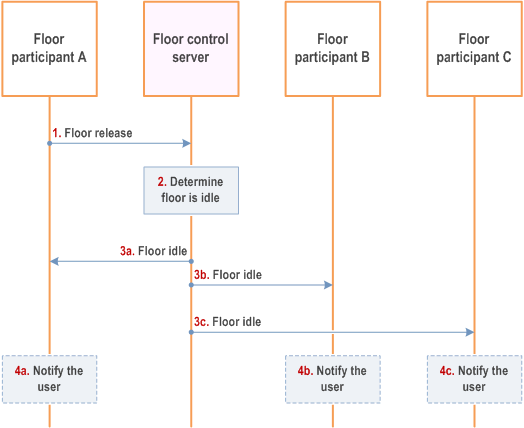
Step 1.
User A stops talking and wants to stop sending voice media over the session. The floor participants A sends the floor release message to the floor control server.
Step 2.
The floor control server determines the floor is idle, e.g., all the floor requests are processed and no new floor request is received. For multi-talker control case, the floor control server determines that the floor participant A was the last talker.
Step 3.
The floor control server sends the floor idle message to the participants.
Step 4.
Floor participants may notify the MCPTT users that the floor is idle.
10.9.1.3.6 Floor revoke by the authorized user |R19| p. 181
Figure 10.9.1.3.6-1 shows the high level procedure that the floor granted to a talker user is revoked by the authorized user. Only three MCPTT UEs involved in the session are shown on the figure for the simplicity.
Pre-condition:
- The participant B is granted the floor and transmitting the voice media to the group.
- For multi-talker case, there may be other talkers in the group communication.
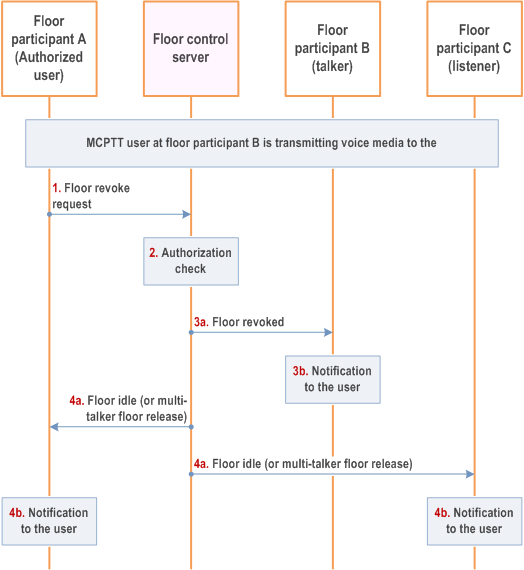
Step 1.
In multi-talker case it is also possible there are other remaining active talkers holding the floor. In such a case, the floor control server sends a Multi-talker floor release message to the other participants.
The authorized user at floor participant A sends floor revoke request message to revoke the floor of floor participant B. The identity of the floor participant B whose floor is to be revoked is included.
Step 2.
The floor control server checks the floor participant A is authorized to perform the floor revoke.
Step 3.
The floor control server sends the floor revoked message towards the floor participant B, and the floor participant B notifies the MCPTT user about the floor is revoked.
Step 4.
The floor control server sends the floor idle to the other participants, and the MCPTT user is notified about the floor is idle.